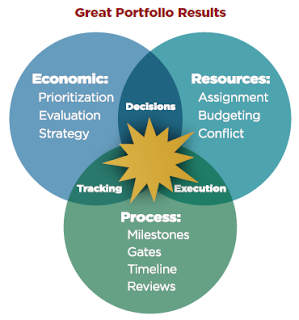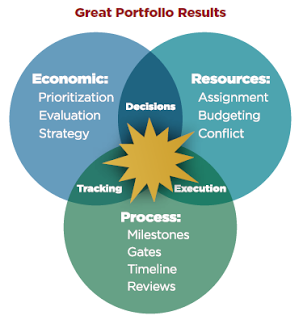Conference
The 6 Principles of Strategic Portfolio Management

By: Don Creswell, Co-founder & Vice President, SmartOrg Inc.
During the
past 20 years, companies have greatly process and systems for managing the
'operational' aspects of project/portfolio management (PPM) ' budgeting, project
management, resource planning, StageGate and phase gate processes.
past 20 years, companies have greatly process and systems for managing the
'operational' aspects of project/portfolio management (PPM) ' budgeting, project
management, resource planning, StageGate and phase gate processes.
Strategic portfolio management, while practiced for many
years by leading companies in pharmaceuticals, oil and gas and aerospace, is
only now emerging as the next step in the maturity of PPM.
years by leading companies in pharmaceuticals, oil and gas and aerospace, is
only now emerging as the next step in the maturity of PPM.
How does Strategic
Portfolio Management (SPM) differ from Project/Portfolio Management (PPM) and
why does it matter?
Portfolio Management (SPM) differ from Project/Portfolio Management (PPM) and
why does it matter?
Early adopters of strategic portfolio management
characterized the difference between 'strategic' and 'operational' as 'doing the
right projects' vs. 'doing the project right.' They recognized that large
amounts of money were wasted on project/product failures (80% of more of new
products fail according to numerous studies).
characterized the difference between 'strategic' and 'operational' as 'doing the
right projects' vs. 'doing the project right.' They recognized that large
amounts of money were wasted on project/product failures (80% of more of new
products fail according to numerous studies).
Many companies have found that while operational processes
and tools have improved results, they fall short when addressing decisions
around selecting the best projects in which to invest and how best to allocate
capital and other resources to optimize the value of project and product
portfolios.
and tools have improved results, they fall short when addressing decisions
around selecting the best projects in which to invest and how best to allocate
capital and other resources to optimize the value of project and product
portfolios.
To optimize decision that drive top-line and bottom-line
value, companies need to consider three distinct areas: economic, resources and
process. The Venn diagram show how these areas relate to value creation.
value, companies need to consider three distinct areas: economic, resources and
process. The Venn diagram show how these areas relate to value creation.
Economic ' Decisions
in this area underpin strategy and relate wo what; selecting the most promising projects in which to invest,
allocating resources, and developing a balanced risk vs. reward portfolio.
in this area underpin strategy and relate wo what; selecting the most promising projects in which to invest,
allocating resources, and developing a balanced risk vs. reward portfolio.
Resources - Decisions in this area are fundamental to
'making it happen' and revolve around who:
achieving StageGate goals, allocating and managing human resources, budgeting
and dsy-do-day project management.
'making it happen' and revolve around who:
achieving StageGate goals, allocating and managing human resources, budgeting
and dsy-do-day project management.
Process ' Processes
and decision-support software in this area support how: the project/portfolio management process from ideation and
concepts to commercial launch.
and decision-support software in this area support how: the project/portfolio management process from ideation and
concepts to commercial launch.
Each of the areas within the Venn diagram involves different
decisions, decision makers, processes and tools. The challenge: bring
everything together to avoid sub-optimization of any one area to the detriment
of the whole.
decisions, decision makers, processes and tools. The challenge: bring
everything together to avoid sub-optimization of any one area to the detriment
of the whole.
In this series, we will focus on the Economic area, which sets the
foundation for creating exceptional value through strategic portfolio
management. Through research and consulting experience with dozens of companies
in a wide variety of industries, we have identified dix principles that are
basic to value creation.
foundation for creating exceptional value through strategic portfolio
management. Through research and consulting experience with dozens of companies
in a wide variety of industries, we have identified dix principles that are
basic to value creation.
1.
Aligned
Decision Forum: Include the right people at the right levels at the right
time.
Aligned
Decision Forum: Include the right people at the right levels at the right
time.
2.
Value-Creation
Focus: Focus decisions on creating value at each development stage.
Value-Creation
Focus: Focus decisions on creating value at each development stage.
3.
Credible,
Comparable Evaluations: Employ clear, transparent evaluation frameworks.
Credible,
Comparable Evaluations: Employ clear, transparent evaluation frameworks.
4.
Embrace
Uncertainty and Dynamics: Explicitly identify the impact of uncertainty on
key decision variables and track changes throughout development.
Embrace
Uncertainty and Dynamics: Explicitly identify the impact of uncertainty on
key decision variables and track changes throughout development.
5.
Inclusive,
Collaborative Process: Involve key
stakeholders from ideation to commercialization.
Inclusive,
Collaborative Process: Involve key
stakeholders from ideation to commercialization.
6.
Clear
Communication and Learning: Assess,
track, inform and continuously improve.
Clear
Communication and Learning: Assess,
track, inform and continuously improve.
This
is the first in a series of blogs on The Six Principles of Strategic Portfolio
Management. Subsequent blogs will address each of the six principles in detail.
For further information about SPM processes and decision-support software,
visit www.smartorg.com or contact info@smartorg.com
is the first in a series of blogs on The Six Principles of Strategic Portfolio
Management. Subsequent blogs will address each of the six principles in detail.
For further information about SPM processes and decision-support software,
visit www.smartorg.com or contact info@smartorg.com
